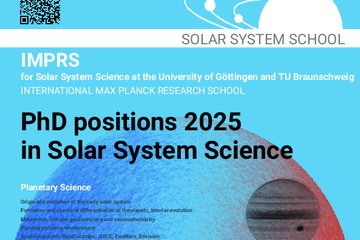All genres
141.
Talk
Mercury's Dust Environment. International Workshop ''Mercury's Surface Response to the Interplanetary Environment: Identifying Needed Studies in Laboratory Astrophysics"
, Online (2022)
142.
Talk
Predictions of Cometary Meteoroid Stream Traverses for the Martian Moons eXploration (MMX) Mission. 1st European Hypervelocity Impact Risk Assessment Forum, Online (2021)
143.
Talk
Flug zum Merkur - Die Mission der Raumsonde BepiColombo. Volkshochschule Mosbach/Binau , Online (2021)
144.
Talk
Dust Science with the DESTINY+ Dust Analyzer. European Planetary Science Congress 2021, Online (2021)
145.
Talk
Ulysses spacecraft data revisited: Detection of cometary meteoroid streams by following in situ dust impacts. European Planetary Science Congress 2021, Online (2021)
146.
Talk
Der neue Weg ins All - Weltraumfahrt im Umbruch. Volkshochschule in Mosbach/Baden , online (2021)
147.
Talk
Der Mond: Unser nächster Nachbar im All; Mondforschung im Raumfahrtzeitalter. Max-Planck-Institut für Sonnensystemforschung, online (2021)
148.
Talk
Current Status of Destiny+ and updated understanding of its target Asteroid (3200) Phaethon. 52nd Lunar and Planetary Science Conference (LPSC 52), online (2021)
149.
Talk
Philae landing on comet 67P/Churyumov-Gerasimenko and the compressive strength and elastic modulus at the Agilkia landing site derived from SESAME/CASSE touchdown signals. Planetary Exploration Research Center, Chiba Institute of Technology, Narashino, Japan (2020)
150.
Talk
Flug zum Merkur – Die Raumsonde BepiColombo. Gesellschaft für Volkstümliche Astronomie e.V., Hamburg, Germany (2019)
151.
Talk
Raumsonde BepiColombo unterwegs zum Merkur. Wissenschaft am Zapfhahn, Restaurant “Kuckuck”, Göttingen, Germany (2019)
152.
Talk
Dust Modelling for the Destiny+ Cruise Phase to (3200) Phaethon. ESA Topical Team Meeting for the Deep Space Gateway
, Canterbury, U.K. (2019)
153.
Talk
Cosima mineral calibration in preparation of the Rosetta mission. Destiny+ Dust Analyser team meeting, Heidelberg, Germany (2019)
154.
Talk
Dust modelling for the Destiny+ cruise phase. Destiny+ Dust Analyser team meeting, Heidelberg, Germany (2019)
155.
Talk
Interstellar and Interplanetary Dust Modelling for the Destiny+ Mission to (3200) Phaethon. Chiba Institute of Technology, Narashino/Chiba, Japan (2019)
156.
Talk
Galileo, Ulysses, Cassini In-Situ Dust Measurements. International Workshop ''Cosmic Lab" at Chiba Institute of Technology, Narashino/Chiba, Japan (2019)
157.
Talk
Pluto und der Kuiper-Gürtel - Eiswelten am Rand des Sonnensystems. Planetarium Mannheim , Mannheim, Germany (2019)
158.
Talk
Pluto und der Kuiper-Gürtel - Eiswelten am Rand des Sonnensystems. Planetarium Münster , Münster, Germany (2019)
159.
Talk
Cosmic dust - A tool to study remote worlds. Universität Göttingen, Physikalisches Kolloquium, Göttingen, Germany (2019)
160.
Talk
Raumsonde Cassini/Huygens beim Herrn der Ringe. Hildesheimer Gesellschaft für Astronomie , Hildesheim, Germany (2018)











